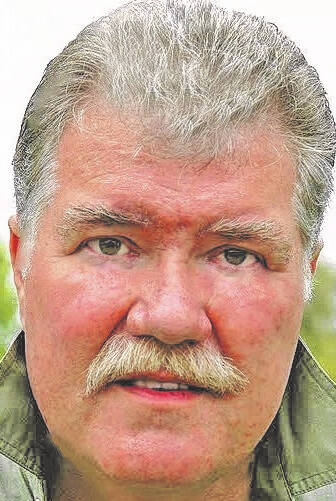
I spotted a pair of whitetail deer the moment I rounded a brushy bend in the small creek.
For the past hour, I’d been fishing my way upstream—going slow, trying to stay focused and thoroughly cover every inch of holding water in the hopes of enticing a few good smallmouth.
Early autumn is a prime angling time for the Buckeye stream addict. Cooling waters and diminishing photoperiods put resident bronzebacks into something of a feeding blitz. It’s as if the fish sense time is growing short for piling on their overwintering reserves.
So far, my best efforts had proved only modestly successful: two bass under a foot in length; several small bluegill and their sunfish kin; one scrappy rock bass.
The stream was clearer than I like—its translucent water only slightly tinged with hues of old jade. Smallmouth bass are alert and wary. You can’t just go sloshing and clattering your way along. So I’d been hugging the edge as I negotiated my way against the slow-moving current—keeping close to the bank in an effort to reduce the chance of spooking a fish in one of the deeper pools with my shadow or silhouette.
Along that same line of careful stalking, I was being mindful of the noise and commotion I made and where I stepped—no rock clattering or gravel crunching.
In many respects, small stream angling is much like stalking squirrels—the better you skulk along, the better your fishing.
Still, it’s not often I manage to sneak up on a deer—especially not two! Yet there they were, fewer than twenty yards away! Mature, well-fed deer. A dandy, 8-point buck and a doe, standing at the lower end of a long pool, just where it began to empty into a shallow riffle.
Two Ohio whitetails totally oblivious to my nearby presence.
I presume that nearby riffle’s gurgling helped mask the sounds of my approach. Perhaps, too, their angle of view and possibly glare off the water’s surface contributed as I slipped around the bend.
Certainly, whatever tell-tale air currents were moving, had to be wafting downstream, carrying my scent away from their sensitive noses.
Doing my best to become just one more innocuous lump within a background of brush and snags, I eased a step sideways and leaned against a convenient sycamore rootmass.
The deer’s pool was overhung by a thick canopy of tall trees and cloistered in deep shadows—except for a single dramatic shaft of mid-morning sunlight which somehow managed to pierce the cool green darkness.
I was immediately struck by how much the scene reminded me of one of those murky old European landscapes you occasionally see hanging on a wall in a dusty museum. A rugged woodland, with jagged rocks and ancient trees, and maybe a castle ruins in the background. And standing in the midst of this sylvan scene, illuminated by a theatrically piercing beam, a fat and magnificent stag.
Unsurprisingly, the painting title is apt to be “Lord of the Forest,” or some such approximate derivative.
Those deer, in that shadowy pool, bathed by a beam of bright sunlight, were a perfect case of life imitating art!
For the next quarter-hour I stood stock still, watching and wondering what those deer were up to and why they were together. It’s a bit early for Ohio’s rut season to be starting. Besides, the two weren’t acting like rutting deer.
In fact, they weren’t doing much of anything except standing in place in a foot or so of water—nose-to-tail, flanks almost touching. Ears flicked; heads turned. Every so often, one or the other would glance around halfheartedly. Or occasionally dip their muzzle into the creek—though I’m not sure they were actually drinking.
But mostly they just stood there like figures in a pastoral diorama. A deer couple, pausing during a morning stroll.
Yeah, I know that’s probably a bit anthropomorphic. But I don’t know how else to explain their odd behavior.
I see deer all the time. Deer along most of the trails and places where I regularly walk, even deer in my yard.
But for the most part, those are animals accustomed to and comfortable with nearby people. Not tame, exactly, but conditioned.
Deer are homebody creatures. Some sources say a whitetail will live out its life and die within a mile of where it was born unless driven to relocate by changing agriculture, lack of browse, or development for housing or industry.
The creek I was fishing was deeply rural—the nearest house was probably a mile away. I have no doubt whatsoever the deer in the stream were wild and wary.
However, I simply can’t tell you what prompted the pair to linger so long in the creek. It was puzzling, at least to me. But they finally turned, sloshed leisurely over to the bank and climbed the slope—then disappeared into a thicket of sumacs fringing the top.
When someone asks me why I fish—particularly, why I so enjoy wading up small backcountry creeks—I think of the countless natural vignettes I’ve witnessed over the years. Moments dramatic or tender, comical, raw, or merely mundane—but totally natural and up close. Such unexpected episodes offer a rare insight into the daily lives of creatures we generally glimpse only after they’ve become aware of our presence.
If I fished the rest of the day without so much as a bump, I would gladly count the time as payment in full for my front-row seat and the unexpected privilege of witnessing those two whitetails in their mid-morning, midstream interlude…even if I still don’t understand what they were doing!
Reach Jim McGuire at [email protected].

